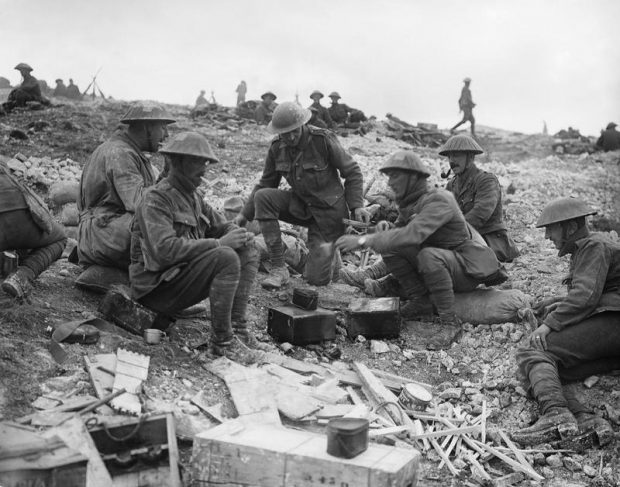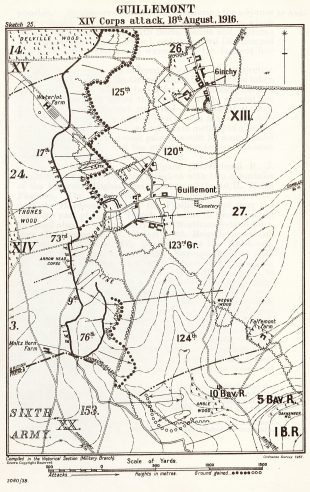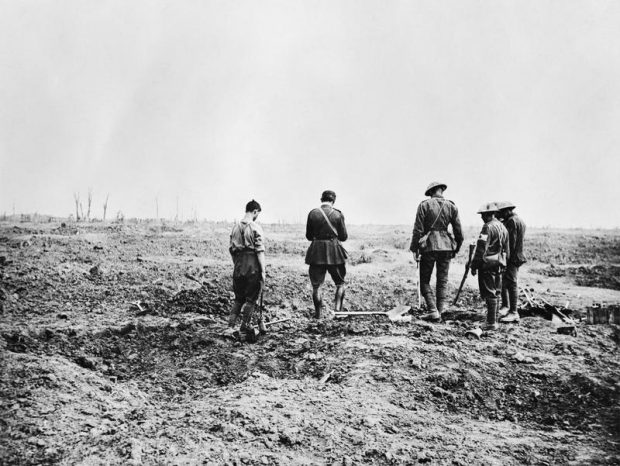The Battle of the Somme, fought between July and November 1916, was one of the defining events of the First World War. With more than one million casualties on all sides during the 141 days of the battle, virtually every community in the UK was affected. We continue to chart key moments in the battle, remembering the sacrifice of those who were injured or lost their lives.
Colonel (Retired) Hugh Boscawen, formerly of the Coldstream Guards, tells the story of the Anglo-French assault on 18 August 1916 in which his great uncle, Captain the Hon. Thomas Boscawen MC, fought. Born in 1892, Tommy Boscawen served in 3rd Battalion The Rifle Brigade during this Somme assault, after joining the Army in July 1914. He was awarded the Distinguished Service Order for his gallant leadership after his company took their objectives without losing a single casualty.

Many have visited the Somme battlefields this summer, commemorating those who fought in the First Day attacks on 1 July 1916 and in later battles, including the major assault on Bazentin Ridge (14-17 July).
Following the battles in mid-July, German troops started to adopt new tactics in order to escape the destruction that British artillery could bring down on their trenches. They began to disperse troops into shell holes, with machine guns supporting further back, so that British bombardments could not destroy infantry and weapons in trenches that could be spotted from the air. The large woods, such as High Wood dominating Bazentin Ridge and Delville Wood, were also proving very difficult to capture and hold. Fighting, supplying troops and evacuating casualties were extremely hard in woodland which heavy shelling had reduced to a mass of fallen, splintered trees and craters.
General Sir Douglas Haig, British Commander-in-Chief, was sensitive to French criticism of British tactics, and in early August his counterpart, General Joseph Joffre, demanded a strong joint attack on the German defensive line near Maricourt. Practical co-operation was difficult, however, and the attacks had mixed results. Haig and Joffre then agreed on a major effort on 18 August between the villages of Guillemont and Maurepas. British troops from Lieutenant General Lord Cavan’s XIV Corps, which was gaining a fine reputation during the Somme battles, were to attack between Delville Wood and the French Army: the village of Guillemont was in the centre of this attack. Showery weather produced the notorious Somme mud but a 36-hour bombardment was fired and, in order to gain surprise, the rate of firing did not intensify before Zero Hour.

Zero Hour was set for 2.45pm; the bombardment now focused on No Man’s Land and using the new tactic of a “creeping barrage”, which involved a curtain of shells moving forward in stages just ahead of the advancing infantry. A British infantry regiment captured the German trench on the edge of Guillemont, meanwhile, the 3rd Battalion The Rifle Brigade advanced by having groups of men rushing forward a few paces while those beside them lay flat and gave rapid fire, before dashing forward themselves. Their attack proved successful and the Riflemen soon entered German trenches north of the village. Part of the Battalion – including Captain Boscawen’s ‘B’ Company - pressed on through Guillemont station, which was by then a few broken railway lines and shattered trucks. They then captured their second objective - trenches on the Longueval to Guillemont road. Groups of Riflemen advanced along the trench throwing grenades - a tactic known as ‘bombing’ - while similar groups from the neighbouring battalion worked their way towards them. It was remarkable that ’B’ Company had taken their objectives without losing a single casualty.
The Commanding Officer of 3rd Rifle Brigade, Lieutenant Colonel Robert Pigot MC, was close by but could not see the progress since the damp day, smoke and dust made visibility very limited. When a Rifleman from ‘B’ Company arrived at headquarters and merely asked for Captain Boscawen’s gloves, which he had left behind, Colonel Pigot only then knew that at least part of the Battalion’s attack, led by the man he called his ‘Fighting Officer’, had been successful. The local success of 3rd Battalion Rifle Brigade was largely due to the combination of traditional methods – accurate rifle fire and advancing in ‘rushes’ – with the newly developed ‘creeping barrage’ fired by the artillery.
Visiting the site of Guillemont station, as I did in July 2006, I was struck by the small size of the 3rd Rifle Brigade's Battalion objective compared to the area that a modern day battle group might expect to attack. Secondly, there is no doubt that Tommy Boscawen's achievement - taking his objective without losing a single man in his company - was very notable indeed, and made me very proud.
Further north, attacks outside the eastern end of Delville Wood also met with success and weakened the German hold; however, 3rd Battalion Rifle Brigade suffered casualties. On 21 August the Battalion attacked again but was unable to take the village of Guillemont. It was only taken on 3 September after a prolonged bombardment.
The attacks on 18 August laid foundations for part of the next major offensive four weeks later. The achievement of 3rd Battalion Rifle Brigade, using both new and traditional methods, relied on complex planning and co-ordination; this took great effort and practice and success could not be guaranteed in every attack. The Army needed something more – and that would be tried out a month later with the very first use of tanks on the battlefield, between the villages of Flers and Courcelette.
Captain Boscawen survived the war and went out to east Africa. He farmed in Tanzania and Kenya, while also exploring and collecting plant and animal specimens in south Arabia, Chinese Turkestan and South America. He died in 1958.
For details of what happened on each of the 141 days of the Battle of the Somme, and to find out where we commemorate Armed Forces personnel who lost their lives, use the Commonwealth War Graves Commission tool at http://www.cwgc.org/the-somme/141-visitors-guide.aspx

